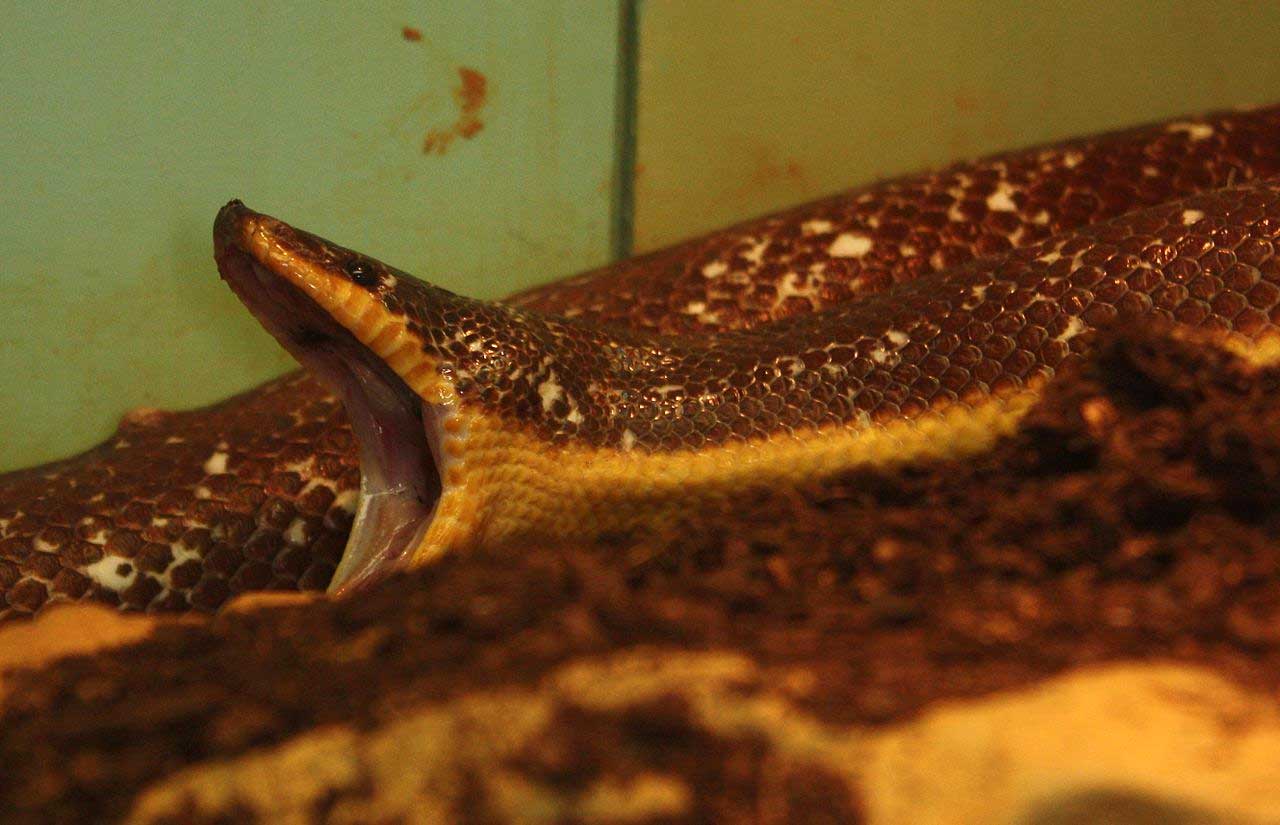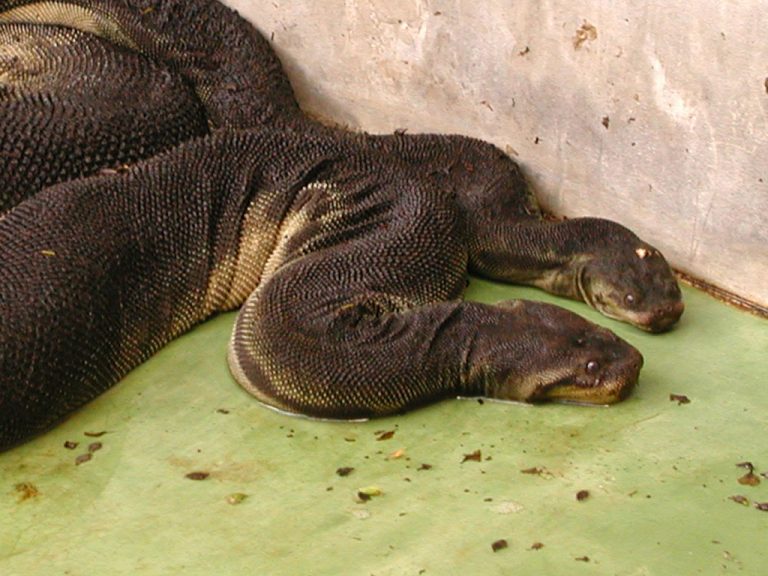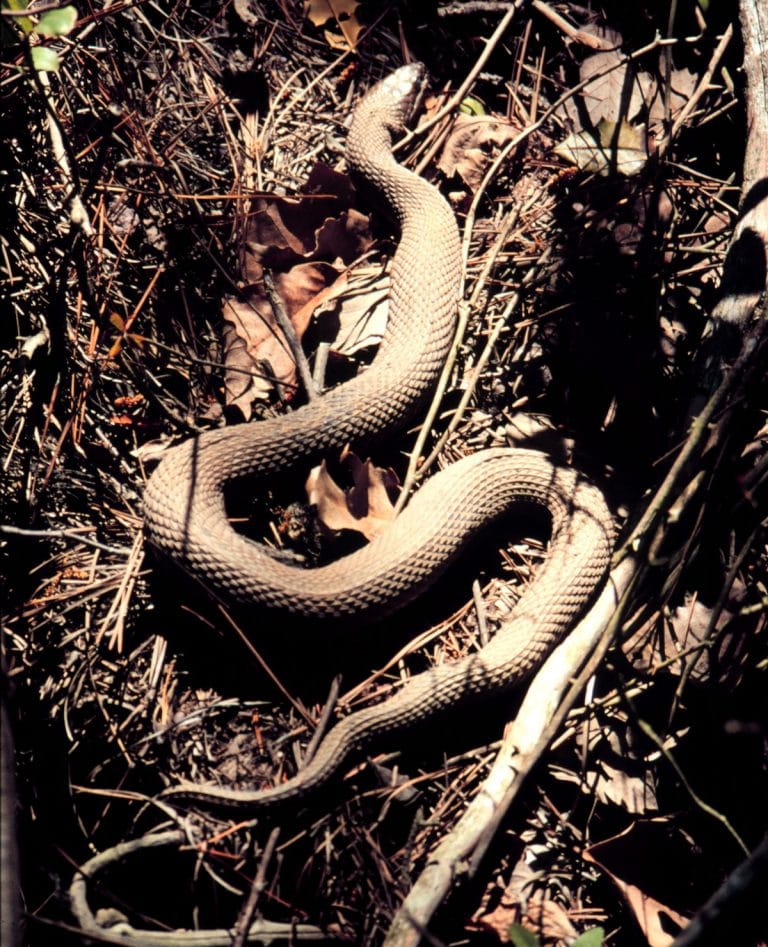Other Snake Families Not Already Described
Scientific Classification
| Kingdom: | Animalia |
| Phylum: | Chordata |
| Subphylum: | Vertebrata |
| Class: | Sauropsida |
| Order: | Squamata |
| Suborder: | Serpentes |
The Suborder Serpentes Includes Two Infraorder Of Snakes
The first Infraorder is Alethinophidia that includes 15 families and then you have the Scolecophidia, that comprises of 3 families
Families under Alethinophidia Infraorder
- The Acrochordidae
- The Aniliidae
- The Anomochilidae
- The Atractaspididae
- The Boidae-(Dealt with separately earlier)
- The Bolyeriidae
- The Colubridae-(Dealt with separately earlier)
- The Cylindrophiidae
- The Elapidae-(Dealt with separately earlier)
- The Loxocemidae
- The Pythonidae-(Dealt with separately earlier)
- The Tropidophiidae
- The Uropeltidae
- The Viperidae-(Dealt with separately earlier)
- The Xenopeltidae
The Infraorder Alethinophidia – Families of Snakes
Acrochordidae

These are generally called Java wart snakes, Dogface snakes, Wart snakes, file snakes, Elephant trunk snakes,
This Acrochordidae belongs to the family of Monogenerics (containing only a single genus.) formed for the Acrochordus genus. These ancient families of water snakes are seen in Indonesia and Australia. Presently 3 of the varieties are acknowledged.
The range of these types of snakes extends from Sri Lanka and India all over the tropics of the southeastern regions of Asia merging to the Philippines, southwards along the Malaysian-Indonesian group of the Islands towards Timor, from east along the New Guinea towards the Coastal regions of North Australia towards Mussau Island, The Guadalcanal Island and Archipelago Bismarck and in the Solomon Islands.
All these are purely water snakes, without the broad scales on the belly that the majority of the snakes have and with eyes placed on their dorsal side. Their scales and skin are the prominent characteristic. The skin is saggy and loose-fitting; this makes it to look multi-sized, and very big for a snake. The scales, instead of overlapping each other, project in the shape of pyramids by which they got their general names. These are ambush snake predators, they lie and wait at the bottom of the streams, rivers and estuaries, looking for fish to arrive and as soon as the fish appears, they grasp it by coiling. In spite of the coating of mucus they are able to grasp the fish with their rough scales. The length of the matured ones ranges from 60 cm to 2.43 m.
Aniliidae – Generally called Coral Pipe Snakes

The Aniliidae belong to the monotypic (no subspecies) group formed for the Anilius genus, that include the unique variety Anilius Scytale. The normal names are pipe snake or false coral snake. You will come across them in the South Americas. Two cloacal spurs represent the vestigial (a body anatomy that has decreased in size, and is of no current use) pelvic girdle. This snake is ovoviviparous. They mainly feed on other varieties of reptiles and amphibians. At present there are two subordinate varieties acknowledged. We find these species in the Amazon Regions of South America, Tobago, Trinidad and the Guianas. This normal sized snake is almost as long as70 cm (27 in). This variety is documented as ovoviviparous and consumes Caecilians (amphibians that burrow), beetles, tiny fossorial snakes, frogs, legless Lizards, and fish. Their features are: cylindrical body with homogenous diameter and a tiny tail; the bands are in bright colors of black and red (in the absence of yellow colored bands); below the big scales on the head they have small eyes.
Contemporary grouping limit the group to the fake coral Pipe snake also called Anilius Scytale or those belonging to the southern part the US, the red pipe snake.
Anomochilidae
Generally called: dwarf pipe snakes, anomochillds or the Anomochilidae, belong to the monotypic group formed for the Anomochilus genus, at present comprising of three varieties of monotypics. This peculiar variety possesses a tiny head that is not visible by the neck, the shields are huge and homogenous. The tiny eyes are clearly visible through the shields around it. Their nostrils appear in single nasal cavity, joined behind the rostral as a suture. They have a cylindrical body and smooth scales on the back in rows of 27 numbers. They have tint blunt tails. You can see them on the Islands of Indonesia of Sumatra.
Atractaspididae: Stiletto Snake

The Atractaspididae group of snakes are inhabitants of the Middle East and Africa, generally named mole vipers, burrowing asps or stiletto snakes. These groups of snakes are included among the other genus previously grouped in different families, based on their type of fangs. This is inclusive of rear-fanged (opisthoglyphous), viper-like (solenoglyphous), fangless (aglyphous) and fixed-fanged (proteroglyphous) varieties. The majority of this type of snakes do not harm, rather they are too small to inject venom in properly into a person. Even then certain snakes are capable of causing pain in the tissues by necrosis; for example. In case it bites the victim’s thumb, that person may lose the tip of the thumb. Deterioration is possible in the long run. The mortality rate on account of this snake is scarce.
Bolyeriidae: The Round Island Boa

These are generally called the Round Island boas, or split jaw snakes, this Bolyeriidae type of snake belong to the group of snakes inhabiting the Mauritius and some neighboring islands, particularly the Round Island. Previously they were found on the Mauritius islands, but because of human intervention and foraging by pigs particularly they were set free. Earlier these snakes were grouped along the Boidae family, but presently they are grouped in a separate family.
Cylindrophiidae

Generally called Asian pipe snake, they include the Red-tailed pipe snake, C. Ruffus
The Cylindrophiidae belongs to the monotypic group of snakes that are not poisonous and of the Cylindrophiidae genus inhabitant of Asia. These snakes burrow, their bellies have white and black checks. At present three varieties are documented, having no subdivisions. You can find them in the Malay Archipelago along the eastern regions of the Aru Islands down to the Southern west coast of New Guinea. You can also see these snakes in south China (on Fujian, Hainan Island and Hong Kong), and also in Laos. These types of snakes have 10 to 12 teeth in each maxillary and none in the pre-maxillary. You cannot distinguish the tiny head from the neck. They have tiny eyes, having pupils that are vertically semi-elliptical or round. The head is protected by big symmetrical shields. In one nasal they have both the nostrils joined at the back of the rostral. They possess Preocular (in front of the eyes) or Loreal (post nasal scales), and also a tiny post ocular (behind the eye). Besides, there is a cerebral groove. They have a very tiny and blunt tail and a cylindrical shaped body.
Loxocemidae: The Mexican Burrowing Python

Generally they are called: Mexican burrowing, Mexican burrowing python, Mexican python snake.
The Loxocemidae belong to a single group of snakes formed for the single Loxocemus genus that includes the type L. Bicolor that you can see in Central America and Mexico. This is one among the smallest family of snakes, of a single variety and single genus. The normal size of the Loxocemidae is about 91 cm (3 ft), but when fully grown, it reaches a length of 1.57m (62 in). Their body is fat and has muscles, a snout in the shape of a shovel, tiny eyes to enable them to burrow and a thin head. You can best describe this type of snake as semi fossorial or terrestrial and partially adapted to digging. Their outline colors are normally shady with white blotched scales, sometimes following skin shedding, the pigments vanish and the snake becomes white in color, except for a tiny dark blotch remaining on the head. They inhabit multiple habitats like dry and moist forests, and tropical forests. You can find them in Guatemala and Honduras, and also in arid inland valleys that seep into the Caribbean. It is alleged that they feed on lizards and rodents. Besides, you can find them eating iguana eggs. Being oviparous, they lay 2 to 4 eggs in a clutch.
Tropidophiidae – Dwarf Boa
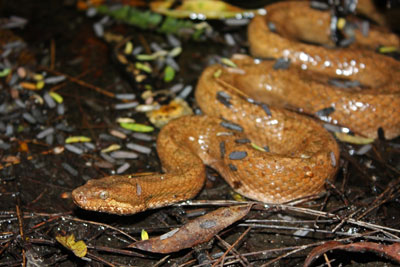
The general name of Tropidophiidae, is the dwarf boa, and they are a group of snakes that are not poisonous. You can find them in West Indies and the southeastern regions of Brazil and Mexico. These are a medium to small-size of burrowing snakes, and a few having brilliant and prominent colored designs. At present there are 22 varieties within 4 genus that are limited to the Neotropical regions, chiefly Jamaica, Hispaniola and Cayman islands, with the most varieties existing in Cuba, where novel varieties have been discovered. This incredibly small snake grows to an average length of 30 to 60 cm (12 to 24 in) in all (inclusive of the tail). Most of these snakes use their time during the day either burrowing below the ground or beneath plants, and they come out to the surface only when it rains or at night. Certain varieties live on trees and are frequently observed concealing themselves in its cavities. The dwarf boa can modify its color from dull (when they are lively during night time) to a bright color (when inactive at day). This modification is obtained by the movement of the granules of bright pigment. When endangered; the tropidophiids wind up into a rigid ball. Another strange defense mechanism is their capability to willingly bleed through their mouth, eyes and nostrils.
Uropeltidae

Generally called: shield-tailed snakes, pipe snakes.
The Uropeltidae belong to the ancient group of snakes that burrow and are wide spread over Sri Lanka and South India. The end of the tail has a big keratinous (fibrous structural proteins) protection. These small snakes when fully grown become 20 to 75 cm long. They are tailored diggers, which you can observe in their anatomy. They have a prehistoric type of skull, which is not flexible, they have small eyes that disintegrate, covered by polygonal shields instead of a brille. Their tail is peculiar, perhaps big fixed scale or a distended big plate of spines.
Their main food is invertebrates, like, earthworms. All snakes associated with this group have eggs hatching inside the mother’s body (ovoviviparous).
Xenopeltidae
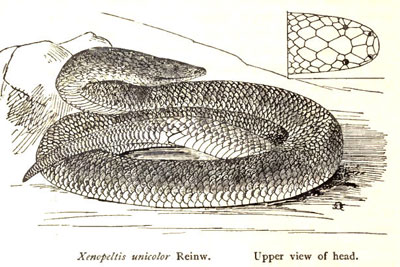
Generally called: sunbeam snakes.
The Xenopeltidae belongs to the monotypic family of snakes formed for the Xenopeltis genus; You can find them in Southeast Asia. This variety is famous for their most glistening scales. At present a couple of species are acknowledged and there are no subordinated species. Study about their DNA suggest that the Xenopeltids seem strongly related to the Burrowing Python (Loxocemus) hailing from Mexico and also other pythons. Grownups reach 1.3 m (51 in). The scales on their head consist of very big plates almost like the Colubridae, whereas their ventral scales are a bit smaller. The remnants of the pelvis are absent. The pattern of color on their back is brown, red brown, or black hue. Their gleaming scales present a colorful picture in the sunlight. These reptiles are diggers, and so, spend most of their time hiding. They come out during the dusk and dynamically go in search of food such as smaller mammals, other kinds of snakes and frogs. They constrict and smother their prey to death, since they are not poisonous.
The Infraorder Scolecophidia – Families of Snakes
Anomalepididae
The Anomalepididae belong to the non-poisonous variety of snakes, which you see in the South of America as well as Central America. They are same as the Typhlopidae. Only a few varieties have only one tooth in their lower jaw. At present 15 varieties and 4 genera are acknowledged. These reptiles are small in size, and normally they are as long as 30 cm (12 in), their tails and heads are blunted. These reptiles are primarily fossorial on account of which, they possess vestigial eyes. Their range extends from the North West of South America to the South Central America. They are scattered over the Southeast as well as the northeast regions of South America.
Leptotyphlopidae

The Leptotyphlopidae (generally named thread snakes or slender black snakes), are a group of snakes seen in the continents of Asia, South America and also in Africa. All these snakes are diggers and have adapted to burrowing, consuming termites and ants. They are divided into two genera of 87 varieties. These reptiles are comparatively small in size and measure about 30 cm; the ones that grow bigger are the L. Occidentalis and the Leptotyphlops Macrolepis.
They have an immovable upper jaw and skull, and also they do not have any teeth in the upper jaw. Their lower jaw is lengthened and four boned, with a compound small bone that is also a comparatively bigger denture bone. The shape of their body is like a cylinder, with short tail and blunted head. Their scales are extremely glossy. They are shielded from the assault of the termites because they produce pheromones. These snakes that are the smallest on earth, are seen in the Western regions of Asia starting from eastern parts of India to Turkey, Africa. You can also see them starting from the Southwest provinces of the United States, ranging over Central America to South America and Mexico, and over the Socotra Island. They are seen in an extensive range of environments, starting from the rainforests to the dry regions and they prefer to live near the colonies of the termites and ants. They frequently consume grownups, pupae and larvae of ants and termites. The majority of the varieties suck the substance inside the bodies of these insects and dispose of the outer skeleton. The snakes belonging to this group are oviparous.
Typhlopidae – Generally Called: Blind Snakes

The Typhlopidae belong to the blind snake family. They occur primarily in the tropics of Asia, Africa, North and South America, over Australia’s mainland and on many islands. Their rostral scales that hang over the snake’s mouth, appear like a shovel used to burrow. They dwell within the burrows, because of poor sight; their eyes are vestigial. The black spots in their eye enable them to detect light. Only their upper jaws have teeth. There is a scale in the shape of a horn at the end of the tail. The majority of these snakes is oviparous. They inhabit most of the subtropical and tropical regions the world over. In particular, you find them in the tropics of America, Pacific Islands, Asia, and Southeast of Europe and Africa.

Having discovered a fondness for insects while pursuing her degree in Biology, Randi Jones was quite bugged to know that people usually dismissed these little creatures as “creepy-crawlies”.

